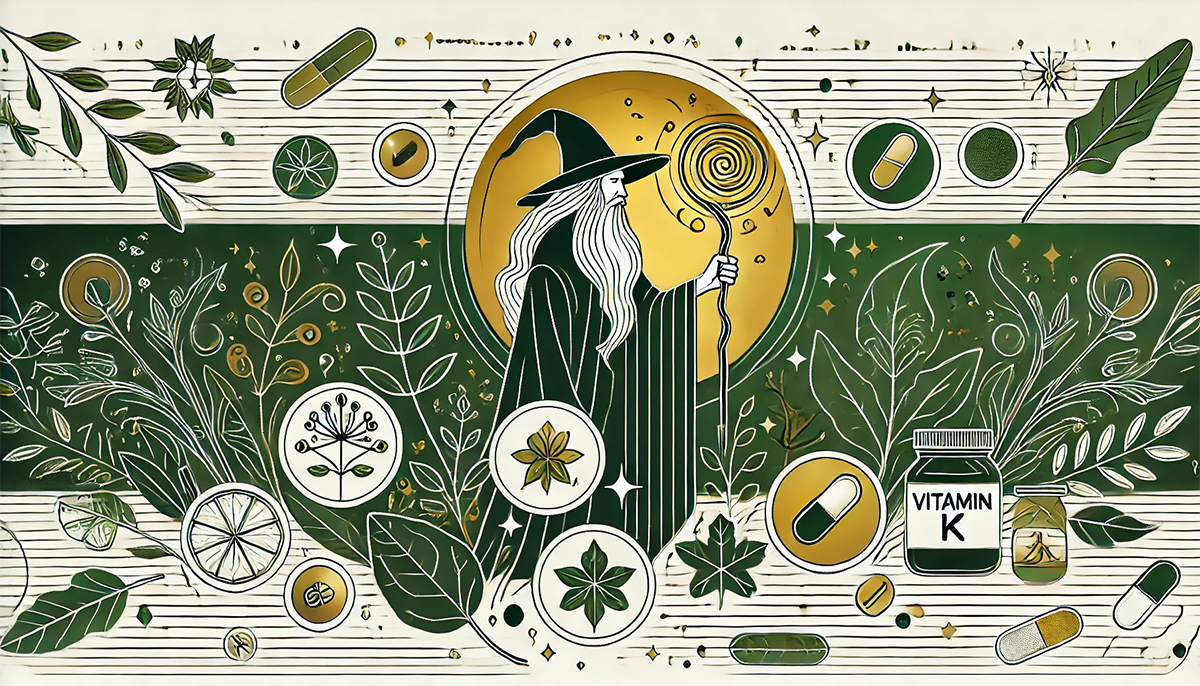Introduction: Vitamin K, the Clotting Crusader
Say hello to Vitamin K—the leafy green kingpin of the vitamin crew, quietly ruling blood clots and bone strength like a backstage boss. Named for “Koagulation” (German for clotting, naturally), this fat-soluble fiend has been stitching wounds and fortifying skeletons since spinach was a thing. From battlefield bandages to modern labs, K’s tale is one of crimson courage and calcium swagger. Let’s slice into the saga of Vitamin K!
1. The Chemistry of Vitamin K: The Green Grease
Vitamin K comes in two flavors: K1 (phylloquinone) from plants and K2 (menaquinone) from bacteria and beastly bits. Chemically, it’s a naphthoquinone with a fat-loving tail—think C31H46O2 for K1, morphing into longer chains for K2. It’s the spark plug for enzymes that slap calcium where it belongs: clotting proteins and bone matrix. Bonus quirk: it’s a fat-soluble glow-up—pair it with butter for the win!
2. The Clotting Chronicles of Vitamin K
Flash back to 1929: Danish doc Henrik Dam fed chicks a fat-free diet and watched them bleed out. Weird, right? By 1935, he pinned it on a mystery nutrient—Vitamin K, dubbed for its clotting clout. Warfarin, a rat poison turned blood thinner, crashed the party in the ‘40s, blocking K’s magic—cue the anticoagulant age. Meanwhile, spinach and liver kept soldiers stitched up. Science win: K’s role in gamma-carboxylation (fancy protein tweak) got Dam a Nobel in ‘44.
3. Vitamin K Treasure Trove: Everyday Eats
K’s hiding in plain sight:
-
- Greens: Kale (1 mg per cup), spinach (0.5 mg)—leafy lords.
- Veggies: Brussels sprouts, broccoli (0.2 mg per cup)—cruciferous cash.
- Oils: Soybean, canola (0.1 mg per tbsp)—slick shots.
- Meats: Liver (0.1 mg per 3 oz), pork—carnivore kicks.
- Dairy: Cheese, eggs (0.01–0.05 mg)—subtle sprinkles.
Daily dose? 90–120 mcg for adults—greens get you there fast.
4. Exotic Vitamin K Superstars
Rare beasts pack a K punch:
-
- Natto: Fermented soy goo (1,000 mcg per 100g)—Japan’s K2 king, stinky and sticky.
- Goose Liver: 0.4 mg per 100g—foie gras flexes hard.
- Kimchi: Fermented funk (0.1 mg per cup)—gut-brewed K2.
Ancient diets leaned on these—think Viking fish livers or samurai soy ferments.
5. Health Benefits: K’s Superpowers
Vitamin K’s a stealthy titan:
-
- Clot Commander: Fuels proteins (like prothrombin) to plug leaks—bleed less, live more.
- Bone Builder: K2 steers calcium into osteocalcin—stronger bones, fewer snaps.
- Heart Hero: Keeps arteries soft—less calcium crust, more flex. Studies say K2 cuts artery stiffness by 12%.
- Bruise Buster: Low K? You’re a walking canvas—top up for tighter skin.
- Brain Buddy: Early buzz links K to neuron health—Alzheimer’s shield? Maybe.
Stat attack: 30% of folks slack on K—veg haters and antibiotic junkies, heads up!
6. The Dark Side: Vitamin K’s Quiet Quirk
K’s chill, but watch out:
-
- Deficiency Drama: Bleeding gums, endless bruises—rare unless you’re gut-shot (think Crohn’s) or warfarin’d up.
- Overdose? Nah: Excess K just shrugs—fat stores it, no sweat.
- Foes: Antibiotics zap gut-made K2; blood thinners like warfarin feud hard—docs balance it tight.
Miss it? Newborns get a K shot—their guts don’t brew it yet. Aim for 100 mcg—piece of kale.
7. Vitamin K in Action: Forms Galore
Grab your K fix:
-
- Food First: Kale, natto, liver—nature’s steady drip.
- Supplements: K1 pills (50–500 mcg) or K2 drops (100–1,000 mcg)—bone buffs love ‘em.
- Fermented Friends: Kombucha, kefir—micro K2 boosts.
- Topical Twist: K creams for bruises—jury’s out, but hype’s real.
Hack: Fat’s your friend—olive oil amps K’s uptake.
8. Conclusion: The Verdant Vanguard of Vitamin K
Vitamin K’s the green glue—binding your blood, bolstering your bones, and keeping your heart humming. From battlefield bleeds to natto bowls, K’s a silent stunner. Chomp some kale, scarf some liver, or pop a pill—however you roll, K’s your crimson-and-calcium captain. In the vitamin lineup, this one’s the leafy heartbeat.
Bonus Nuggets:
-
- Baby Boost: Newborns get a K jab—first-day heroics.
- Space Snack: Astronauts munch K-rich greens—bones hate zero-G.
- Old Trick: Romans boiled nettles for K—stinging soup, clotting gold.
List of all Vitamins:
| Vitamin | Where | % Daily Intake (DI) |
|---|---|---|
| Vitamin A | Liver, carrots, sweet potatoes | 900 mcg (men), 700 mcg (women) |
| Vitamin B1 (Thiamine) | Pork, whole grains, sunflower seeds | 1.2 mg (men), 1.1 mg (women) |
| Vitamin B2 (Riboflavin) | Dairy, liver, spinach | 1.3 mg (men), 1.1 mg (women) |
| Vitamin B3 (Niacin) | Chicken, tuna, peanuts | 16 mg (men), 14 mg (women) |
| Vitamin B5 (Pantothenic Acid) | Eggs, avocado, mushrooms | 5 mg (unisex AI) |
| Vitamin B6 (Pyridoxine) | Salmon, bananas, chickpeas | 1.7 mg (men), 1.5 mg (women) |
| Vitamin B7 (Biotin) | Nuts, eggs, sweet potatoes | 30 mcg (unisex AI) |
| Vitamin B9 (Folate/Folic Acid) | Leafy greens, lentils, fortified grains | 400 mcg (unisex) |
| Vitamin B12 (Cobalamin) | Beef, clams, fortified milks | 2.4 mcg (unisex) |
| Vitamin C (Ascorbic Acid) | Oranges, peppers, strawberries | 90 mg (men), 75 mg (women) |
| Vitamin D | Sun, salmon, fortified dairy | 15 mcg (600 IU, unisex) |
| Vitamin E | Almonds, spinach, wheat germ | 15 mg (unisex) |
| Vitamin K | Kale, natto, liver | 120 mcg (men), 90 mcg (women) |

